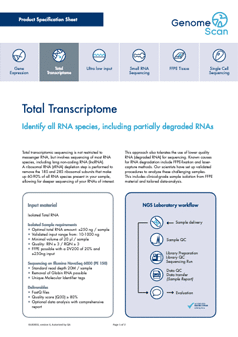Standard gene expression profiling provides you a fast and affordable analysis on protein-coding RNA. With Total Transcriptome, you extend your vision towards all transcripts, including long non-coding RNA (lncRNA) and circular RNA (circRNA) species.

Total Transcriptome

Why analyse total transcriptome?

Comprehensive view of transcription profiles
Total RNA sequencing helps you to overcome common causes for RNA degradation, such as FFPE-fixation and laser-capture methods. Additionally, precious samples from a cohort might not be handled optimally, blocking the only source to obtain transcriptome profiles for your study. Our scientists have set up validated procedures to analyze these challenging samples. This includes clinical-grade sample isolation from FFPE material and tailored data-analysis.
A ribosomal RNA (rRNA) depletion step is usually required, since the 16S and 18S ribosomal subunits make up ~60-90% of all RNA species present in your sample. You make better use of the sequencing space by removing them at the sample preparation phase. What remains is messenger RNA, and many other regulatory types of RNA.
Deliverables overview
- Measurement of all RNA transcripts present
- rRNA depletion and globin reduction are optional
- Challenging samples: The average RNA transcript size must exceed 50 bp to allow for unique mapping and analysis. Check your (column-)isolation procedure to determine from which size (bp) the RNA fragments are retained.
Structural variant analysis
To determine structural variation such as isoforms, splice variants and gene-fusions we advise a sequencing depth of 50 – 100 million reads per sample.

We have summarized key information about our total transcriptome service into a service specification sheet.
Let's get the conversation started for your next NGS project
Please either fill in this form or email us directly at info@genomescan.nl
and we will get in touch with you to discuss your requirements





